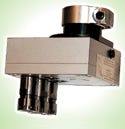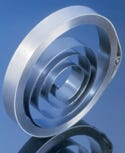For metal fabricators, materials and machines are key to success
June 19, 2006
Originally Published MPMN June 2006
PRODUCT UPDATE
Finding the Right Tools for the Job
For metal fabricators, materials and machines are key to success
|
A continuous wet-processing system from Metfab automatically sharpens, deburrs, and polishes metal parts. |
As metal components get smaller and tolerances get tighter, material selection and equipment capabilities become more important. Using the proper tools can make a difference in the quality of parts, as well as in production and labor costs. This article highlights materials, products, services, and equipment used in metal fabrication. A buyer’s guide with a complete listing of companies that offer metal fabrication services can be seen here.
Electropolishing Systems Sharpen, Deburr, and Polish Automatically
Continuous wet-processing systems are designed for electrosharpening, electrochemically deburring, and electropolishing metal parts. The high-speed systems are custom engineered by Metfab Technologies Inc. (Warwick, RI). The systems can be used in situations where high precision, repeatability, and low unit costs are critical. Each system includes the appropriate reel-to-reel and parts-feeding technologies, fixtures, conveyors, tanks, and controls to sharpen, deburr, and polish automatically. Capable of processing parts up to 20 sq in., these systems provide up to 600% increases in throughput over manual methods, depending upon part configuration, according to the company.
Featuring greater piece-to-piece uniformity than batch methods, the systems are suitable for stainless steels, Monel, Hastelloy, and titanium-related metals. Typical parts processed include medical devices such as scalpels, saws, and screens.
Spindle Technologies Can Simplify Drilling Process
|
Multiple-spindle heads from AutoDrill can drill hole patterns in one step. |
A maker of drill equipment offers adjustable or fixed-pattern multiple-spindle heads. Available for automatic and manual drilling equipment, the heads from AutoDrill (Millington, NJ) can be used on drill presses, milling machines, direct motor mounts, and other platforms.
Single-spindle drilling of multiple- hole patterns can require complicated, costly fixtures, or multiple steps to drill closely spaced hole patterns. When attached to a drilling machine, the multiple-spindle heads can create a pattern in one step. Benefits include increased production and reduced operation and setup errors. Stack-up tolerances are no longer a potential problem and tool changes are less frequent.
The heads are constructed with helical gearing for high spindle-speed ratings and less noise. Full ball- and needle-bearing construction is used throughout for heavy production operation. Readily available precision ER-style collet chucks are built as part of the spindles. One-shot grease lubrication is designed into every head for trouble-free operation. The heads come with adapters for use with CNC machines.
Another spindle uses an alternative taper for steadier tool holding. The SC 50104 spindle offered by Fischer Precise USA Inc. (Racine, WI) can reach speeds up to 30,000 rpm without the need for external bearing lubrication. Within a 100-mm-diam cartridge body and a length of 400 mm, the spindle can provide more than 9 hp in continuous use. Runout of the spindle quillshaft taper is measured at 2 µm or less.
In order to maintain extreme precision in runout and minimal axial movement of the tool, the spindle uses an HSK 32 taper, as opposed to the traditional CAT or steep-taper style of tool holding. The HSK taper has the gripper fingers spread out inside an internal hollow groove of the tool holder. As speed increases, centrifugal force helps keep the tool holder firmly in place. The unit is also liquid cooled to maintain a steady thermal state, which minimizes component growth due to temperature.
Precision Metal Stamping and Tool Design Offered
A company focuses on custom-designed metal stamping. Hobson and Motzer (Durham, CT) produces high-tolerance precision metal stampings and assemblies for medical applications. The company also designs and builds progressive stamping dies and tools. Capabilities include in-house tool design and single-stroke stamping for high-volume production. Component assembly, pad printing, laser welding, and project management are also offered. Press equipment ranges from 30 to 250 tn, and material thickness ranges from 0.001 to 0.150 in. Available metals include stainless steel, copper-based alloys, and a variety of other steels.
Micromanufactured Components Available in Various Metals
A firm with experience in electrochemical and contact machining offers manufacturing of micro- and nanolevel medical components. Point Technologies Inc. (Boulder, CO) offers in-house metal-forming services. The company can make small-diameter wire, tube, and flat-stock metal products as small as 0.0005 in. diam. Available materials include stainless steel, super alloys, refractory metals, nitinol, and noble metals. The company also offers notching, coining, and deburring services.
Strip Steel Has Consistent Hardness
|
Custom strip steel from Blue Blade Steel features consistent hardness and uniformity. |
Automated processes are used to produce strip steel for spring manufacturing. Custom-made to uniform specifications by Blue Blade Steel Co. (Kenilworth, NJ), the steel is precision crafted with consistent hardness from coil to coil. The computer-automated process eliminates soft spots in the continuous coil. The spring steel is packaged in either traditional flat-ribbon coils up to 60 in. outside diam or in compact, oscillating coil spools up to 2000 lb.
The company also offers tempered steel, which can provide consistent, bendable, and pliable materials to offer time- and cost-saving performance characteristics. As a result, product failure resulting from deformation, stress cracking, and brittleness is eliminated. The highly controlled hardening and tempering process enables the firm to selectively modify the internal steel structure to produce material with specialized performance characteristics. Pretempered materials for parts, wear plates, spring washers, and brackets are flexible, easy to work, retain flatness, and produce very little waste from deformation during forming and shallow drawing.
The pretempering process eliminates secondary heat treating, which is the most common cause of distortion and irregular and out-of-spec parts that result in scrap waste, parts failure, and performance problems. The tempering process is computer controlled and provides material uniformity, consistency, and lot-to-lot repeatability. Pretempered high-carbon and alloy strip steel is offered in scaleless blue, polished blue, polished bright, and polished straw finishes.
Blades, Needles Can Be Custom-Made for Surgical Devices
A maker of critical cutting and piercing components offers blades, trocars, custom needles, cannulae, scissors, and biopsy punches for use in minimally invasive surgical devices. IncisionTech (Staunton, VA) manufactures sharp incisional components and assemblies for endoscopic, cardiovascular, ophthalmic, orthopedic, and diagnostic procedures.
IncisionTech uses CNC sharpening and pointing equipment, as well as electrochemical-finishing technology. Other services include electrochemical edge enhancement and deburring, stamping, machining, heat-treating, grinding, EDM, photoetching, forming and deburring, cleaning and passivation, and laser cutting, welding and marking. Coatings, such as parylene, ceramic, Teflon, and Krytox, can be added to the finished product to enhance performance.
Copyright ©2006 Medical Product Manufacturing News
You May Also Like





